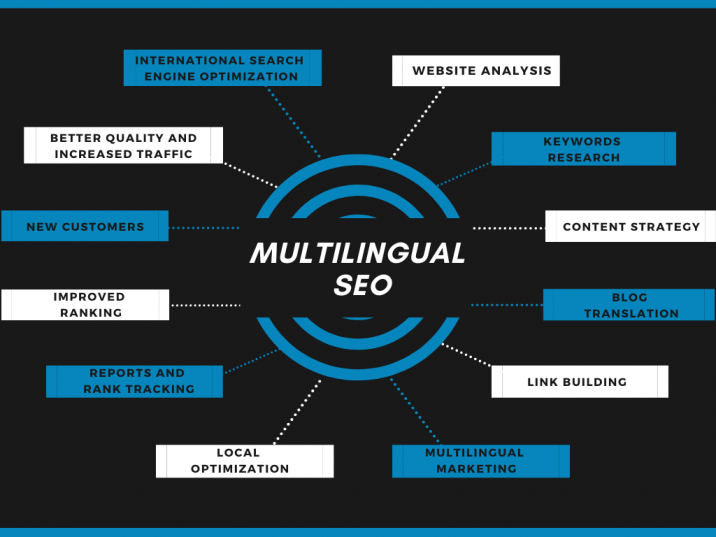
Multilingual SEO is a powerful tool for improving the visibility of your website in different countries and regions, it can be a great way to expand your business to a global market.
This guide will teach you the eight steps necessary to do multilingual SEO. With these steps, you’ll be able to get the most out of your multilingual SEO efforts and reach a wider audience.
What is Multilingual SEO?
Multilingual SEO is the practice of optimizing a website for various languages. It involves adapting your website’s content to different languages. It localizes the elements that help search engines recognize your content.
This can include building backlinks and optimizing tags and creating titles, using hreflang tags, and conducting keyword research specific to each language.
Multilingual SEO techniques are becoming more sophisticated. Companies can gain a competitive advantage by targeting a much larger audience. They can dominate the search engines for their multi-language markets.

Why is Multilingual SEO Important?
A multilingual website is important for taking advantage of the global market. Optimizing your websites for different languages allows you to reach a global audience. A good multilingual SEO strategy has the potential to yield incredible results. In terms of traffic, leads, and, ultimately, sales.
Additionally, all online content competes to appear top-ranked in search engine results. With multilingual SEO, you can increase your chances of appearing higher on the list and making it easier for potential customers to find you. This can significantly improve website clicks, page views, and conversions.
Today, multilingual SEO is increasingly important for businesses—especially those seeking to tap into new markets. Website translation can help improve search engine visibility, ranking, and targeted traffic. However, optimizing a multilingual website can take time and effort. To help businesses get up and running quickly. Here’s an eight-step guide to successfully translating a website for multilingual SEO.
How to Translate Website for Multilingual SEO
1. Implement Hreflang tags
The Hreflang tag is an HTML code. It is needed to help search engines understand which version of a webpage should be served to a particular language or region. The tag should be built into the website’s source code, typically into the <head> section.
2. Multilingual keyword research
Multilingual keyword research involves researching keywords that are relevant to your website. This can be done through a variety of methods. Such as using local search engine data, analyzing competitors, and conducting market research. The research should focus on finding popular keywords in various languages. Keywords that are related to the website or product. This can help to ensure that the website or product is properly marketed to an international audience.

3. Use logical URLs
Having short, logical URLs is important for both users and search engines. All top-level domains should be consistently structured. They must contain only the language or locale designation. For instance, the German language URL for a product page could be set as www.example.de/product.
4. Separate web documents
Search engine crawlers can’t read PDFs, Excel, or PowerPoint documents. They cannot read any other non-HTML documents. So, all non-HTML documents must be moved to the root folder to separate them from the web documents.
5. Label all translated documents
Labeling all translated documents is important. This is done by using the Hreflang tag. Or by using the document title as the label and including relevant keywords.
6. Structure web content correctly
Search engine optimization focuses on the content. You must ensure that the content is correct. So that search engines can index it, even for multilingual searches. You must take care to ensure sentences flow correctly, and use relevant keywords.
7. Monitor international SEO performance
You must monitor international SEO performance and identify issues and opportunities. You can analyze SEO performance to uncover SEO issues. Issues such as broken links and unstructured web pages must get your attention. Regular visits to the website from each locale should also be undertaken. This is to ensure the website is operating correctly in all markets.
8. Use international backlinks
Backlinks to a website from external authoritative sources will boost search engine rankings. So, it’s important to obtain good quality international backlinks. You can do it by seeking international partnerships and formal agreements.
Following these eight steps, businesses can properly set up multilingual websites. And ensure they consistently rank well in search engine result pages in all markets.
How to Translate a Website?
To translate a website, you’ll need to use a translation service. There are many services available online. You can choose from a few different methods of translating a website. The most popular is using Google Translate. It is used in different forms of translation from many different websites.
To use the service, you’ll need to copy the website URL you’d like to translate and paste it into the translator. Once translated, you can then go through and make changes. This includes changing the text, images, styling, and functionality. Depending on the layout of your website, this could be a tedious process.
Suppose you need to translate a larger website or have a tight deadline, you may want to use a professional translator who can do the job faster. Additionally, a professional translator may be able to offer more accurate translations.
Finally, translations can also be done in-house by a development team. This requires knowledge of coding. It might not be an option if your development team has limited skills.
It does not matter which method you choose to translate your website. It’s important to remember that localization is also essential. This means you need to provide a version that is properly suited for the target audience to ensure that the website is successful.

How to Choose the Right Language Service Provider
Finding the right language service provider for a multilingual SEO campaign can be challenging. When choosing, it’s important to consider the provider’s expertise. And experience in SEO multi-language optimization as well as any specialized services they may offer.
It’s also important to make sure the provider uses the latest technologies. This is to make sure the multilingual website SEO is up-to-date and effective. It ultimately helps to optimize your website for multiple search engines.
A good language service provider must have experience in SEO language optimization, including keyword research, content optimization, and link building.
Once you choose the right language service provider for your multilingual SEO campaign, you can rest assured that your campaign will be effective and successful.
Wrapping Up
Translating your website is important for launching globally, but it’s only the beginning of a multilingual SEO strategy. Taking the time to understand each language and prioritize tasks is key to success.
Having a well-thought-out plan and following the eight steps outlined in this guide can help you make the most of your multilingual SEO efforts.
FAQs
Multilingual SEO is a technique used to optimize a website for multiple languages. It ensures that websites are seen and understood by various international users.
To set up a multilingual website, choose the language you want to use and create separate HTML files for different language versions. Additionally, you need to create a language selector and use a translation plugin or hire a translator.
SEO Multi-language optimization involves using search-engine-friendly techniques such as optimizing titles and meta tags in each language, building quality inbound links, creating content for each language, and optimizing navigation across languages.
SEO language is a term used to describe the language used in SEO practices. This includes keyword research, content optimization, link building, and other elements that ensure visibility for the website on search engine result pages.
A multi-language SEO strategy requires optimizing your website for a particular language. This includes researching local keywords and creating language-specific content. It also includes optimizing for local search engines, setting up different language versions of the website. And finally, creating redirects for content translated into new languages.
Latest Blogs
Explore how Google’s 2025 AI search updates triggered ranking chaos. Learn actionable strategies to adapt your SEO for AI Overviews, zero-click searches, and SERP volatility. Stay ahead now.
Learn how to rank on AI search engines like ChatGPT, Perplexity, and Gemini by optimizing your content for authority, structure, and relevance. Stay ahead in AI-driven search with this strategic guide.
Explore the best healthcare SEO services for your medical practice. Improve online visibility and effectively reach more patients in need of your services.
Get your hands on the latest news!
Similar Posts

Content Analytics
8 mins read
Google I/O 2025: AI Search Shake-Up & Ranking Volatility

SEO
5 mins read
Top 10 Agencies for Banking and Financial SEO Services Industry

SEO
4 mins read